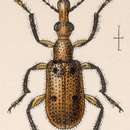Distribution
provided by INOTAXA archive
Hab.MEXICO, Oaxaca (Höge), Atoyac and Fortin in Vera Cruz, Teapa in Tabasco (H. H. Smith).
- license
- cc-by-3.0
- copyright
- Biologia Centrali-Americana
Latin Diagnosis
provided by INOTAXA archive
Rufus, parce setosus; antennis, pedibus elytrorumque maculis quatuor nigris, femoribus omnibus ex parte majore flavis; capite prothoraceque parcissime punctatis, sublævigatis; elytris seriatim subremote punctatis, interstitiis fere impunctatis.
Long. cum rostro 4—4½ millim.
Sharp in: David Sharp & G. C. Champion, May 1889. Biol. Centr.-Amer.,Coleoptera, vol. 4, pt. 3: 31.
- license
- cc-by-3.0
- copyright
- Biologia Centrali-Americana
Physical description
provided by INOTAXA archive
Rostrum very short, broad; head nearly impunctate, the eyes very large, the vertex short. Antennæ very long, quite black, the terminal joint only half as broad as the tenth. Thorax slender, longer than broad, obsoletely and sparingly punctate. Elytra with quite regular series of distant punctures, obsolete at the apex. The tibiæ and tarsi in larger part and the apices of the femora black. Male with the extremity of the middle tibia incurved at the apex.
We have received seven examples of this species, and apparently all are males. The black spots vary greatly in size, and possibly they may be sometimes entirely absent; but, independently of the black spots, the species is easily recognizable by the diminished punctuation of the head and thorax.
- license
- cc-by-3.0
- copyright
- Biologia Centrali-Americana

